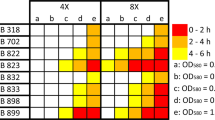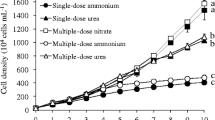Abstract
The interactions between antibiotics and microorganisms have attracted enormous research attentions. In this study, we investigated the effects of two typical aminoglycoside antibiotics on the aggregation of the model cyanobacterium, Synechococcus elongatus, and the dominating strain in algal blooms, Microcystis aeruginosa, via the analysis of zeta potentials, hydrophobicity, and extracellular polymeric substances (EPS) secretion. The results showed that low-level antibiotics promoted the aggregation of S. elongatus and M. aeruginosa by 40 and 18% under 0.10 and 0.02 μg/mL of kanamycin, respectively, which was mainly attributed to the combined effects of increased zeta potentials and the ratio between extracellular proteins and polysaccharides. Tobramycin exerted similar effects. Additionally, we discovered that at low pH (pH 5) and ionic strength (1 mM Na+ and 2 mM Mg2+), the inducing effects of antibiotics would be even larger than those with higher pH and ionic strength. As aggregation is important to cyanobacteria in either the basic physiology of biofilm formation or the algal bloom, our study demonstrated that low-level antibiotics exert ecological impacts via interfered aggregation. We believe this study will shed light on the mechanisms underlying antibiotic-induced biofilm formation and help with the evaluation of the environmental and ecological risks of antibiotics and other emerging pollutants.






Similar content being viewed by others
References
Adav SS, Lee DJ (2008) Extraction of extracellular polymeric substances from aerobic granule with compact interior structure. J Hazard Mater 154:1120–1126
Andersson DI, Hughes D (2014) Microbiological effects of sublethal levels of antibiotics. Nat Rev Micro 12:465–478
Berla BM, Saha R, Immethun CM, Maranas CD, Moon TS, Pakrasi HB (2013) Synthetic biology of cyanobacteria: unique challenges and opportunities. Front Microbiol 4:246
Bernier SP, Surette MG (2013) Concentration-dependent activity of antibiotics in natural environments. Front Microbiol 4:20
Blair JM, Webber MA, Baylay AJ, Ogbolu DO, Piddock LJ (2015) Molecular mechanisms of antibiotic resistance. Nat Rev Micro 13:42–51
Bradford MM (1976) A rapid and sensitive method for the quantitation of microgram quantities of protein utilizing the principle of protein-dye binding. Anal Biochem 72:248–254
Cai H, Jiang H, Krumholz LR, Yang Z (2014) Bacterial community composition of size-fractioned aggregates within the phycosphere of cyanobacterial blooms in a eutrophic freshwater lake. PLoS One 9:e102879
Cao Y-Q, Li Q, Xia P-F, Wei L-J, Guo N, Li J-W, Wang S-G (2017) AraBAD based toolkit for gene expression and metabolic robustness improvement in Synechococcus elongatus. Sci Rep 7:18059
Cohen SE, Golden SS (2015) Circadian rhythms in cyanobacteria. Microbiol Mol Biol Rev 79:373–385
Deng J, Chen F, Liu X, Peng J, Hu W (2016) Horizontal migration of algal patches associated with cyanobacterial blooms in an eutrophic shallow lake. Ecol Eng 87:185–193
Diamond S, Jun D, Rubin BE, Golden SS (2015) The circadian oscillator in Synechococcus elongatus controls metabolite partitioning during diurnal growth. Proc Natl Acad Sci U S A 112:E1916–E1925
DuBois M, Gilles KA, Hamilton JK, Rebers PA, Smith F (1956) Colorimetric method for determination of sugars and related substances. Anal Chem 28:350–356
Eboigbodin KE, Ojeda JJ, Biggs CA (2007) Investigating the surface properties of Escherichia coli under glucose controlled conditions and its effect on aggregation. Langmuir 23:6691–6697
Eboigbodin KE, Biggs CA (2008) Characterization of the extracellular polymeric substances produced by Escherichia coli using infrared spectroscopic, proteomic, and aggregation studies. Biomacromolecules 9:686–695
El Badawy AM, Luxton TP, Silva RG, Scheckel KG, Suidan MT, Tolaymat TM (2010) Impact of environmental conditions (pH, ionic strength, and electrolyte type) on the surface charge and aggregation of silver nanoparticles suspensions. Environ Sci Technol 44:1260–1266
Flemming HC, Wingender J (2010) The biofilm matrix. Nat Rev Microbiol 8:623–633
Hoffman LR, D'Argenio DA, MacCoss MJ, Zhang Z, Jones RA, Miller SI (2005) Aminoglycoside antibiotics induce bacterial biofilm formation. Nature 436:1171–1175
Hou J, Wang C, Mao D, Luo Y (2016) The occurrence and fate of tetracyclines in two pharmaceutical wastewater treatment plants of Northern China. Environ Sci Pollut Res 23:1722–1731
Hu S, Song Y, Bai X, Jiang X, Xl Y (2014) Derivatization and solidification of floating dispersive liquid-phase microextraction for the analysis of kanamycin in wastewater and soil by HPLC with fluorescence detection. CLEAN 42:364–370
Jansson C, Northen T (2010) Calcifying cyanobacteria—the potential of biomineralization for carbon capture and storage. Curr Opin Biotechnol 21:365–371
Jorand F, Boue-Bigne F, Block J, Urbain V (1998) Hydrophobic/hydrophilic properties of activated sludge exopolymeric substances. Water Sci Technol 37:307–315
Kummerer K (2009a) Antibiotics in the aquatic environment—a review—part II. Chemosphere 75:435–441
Kummerer K (2009b) Antibiotics in the aquatic environment—a review—part I. Chemosphere 75:417–434
Kuznar ZA, Elimelech M (2005) Role of surface proteins in the deposition kinetics of Cryptosporidium parvum oocysts. Langmuir 21:710–716
Li Q, Xia P-F, Tao Z-Y, Wang S-G (2017) Modeling biofilms in water systems with new variables: a review. Water 9:462
Li R, Zhao C, Yao B, Li D, Yan S, O’Shea KE, Song W (2016) Photochemical transformation of aminoglycoside antibiotics in simulated natural waters. Environ Sci Technol 50:2921–2930
Liao B, Allen D, Droppo I, Leppard G, Liss S (2001) Surface properties of sludge and their role in bioflocculation and settleability. Water Res 35:339–350
Liu XM, Sheng GP, Luo HW, Zhang F, Yuan SJ, Xu J, Zeng RJ, Wu JG, Yu HQ (2010) Contribution of extracellular polymeric substances (EPS) to the sludge aggregation. Environ Sci Technol 44:4355–4360
Liu Y, Fang HH (2003) Influences of extracellular polymeric substances (EPS) on flocculation, settling, and dewatering of activated sludge. Crit Rev Env Sci Tec 33:237–273
Ma X, Wang Y, Feng S, Wang S (2015) Vertical migration patterns of different phytoplankton species during a summer bloom in Dianchi Lake, China. Environ Earth Sci 74:3805–3814
Matson MM, Atsumi S (2018) Photomixotrophic chemical production in cyanobacteria. Curr Opin Biotechnol 50:65–71
McEwen JT, Machado IM, Connor MR, Atsumi S (2013) Engineering Synechococcus elongatus PCC 7942 for continuous growth under diurnal conditions. Appl Environ Microbiol 79:1668–1675
Oliveira NM, Martinez-Garcia E, Xavier J, Durham WM, Kolter R, Kim W, Foster KR (2015) Biofilm formation as a response to ecological competition. PLoS Biol 13:e1002191
Paerl HW, Otten TG (2013) Harmful cyanobacterial blooms: causes, consequences, and controls. Microb Ecol 65:995–1010
Parmar A, Singh NK, Pandey A, Gnansounou E, Madamwar D (2011) Cyanobacteria and microalgae: a positive prospect for biofuels. Bioresour Technol 102:10163–10172
Pembrey RS, Marshall KC, Schneider RP (1999) Cell surface analysis techniques: what do cell preparation protocols do to cell surface properties? Appl Environ Microbiol 65:2877–2894
Ridgwell A, Zeebe R (2005) The role of the global carbonate cycle in the regulation and evolution of the Earth system. Earth Planet Sci Lett 234:299–315
Sanchez-Iglesias A, Grzelczak M, Altantzis T, Goris B, Perez-Juste J, Bals S, Van Tendeloo G, Donaldson SH Jr, Chmelka BF, Israelachvili JN, Liz-Marzan LM (2012) Hydrophobic interactions modulate self-assembly of nanoparticles. ACS Nano 6:11059–11065
Stewart PS, Costerton JW (2001) Antibiotic resistance of bacteria in biofilms. Lancet 358:135–138
Tan L-R, Xia P-F, Sun X-F, Guo N, Song C, Li Q, Wang S-G (2016) Ecological insights into low-level antibiotics interfered biofilms of Synechococcus elongatus. RSC Adv 6:78132–78135
Taton A, Ma AT, Ota M, Golden SS, Golden JW (2017) NOT gate genetic circuits to control gene expression in cyanobacteria. ACS Synth Biol 6:2175–2182
Välitalo P, Kruglova A, Mikola A, Vahala R (2017) Toxicological impacts of antibiotics on aquatic micro-organisms: a mini-review. Int J Hyg Environ Health 220:558–569
Wang L, Liang W, Yu J, Liang Z, Ruan L, Zhang Y (2013) Flocculation of Microcystis aeruginosa using modified larch tannin. Environ Sci Technol 47:5771–5777
Wang ZW, Liu Y, Tay JH (2005) Distribution of EPS and cell surface hydrophobicity in aerobic granules. Appl Microbiol Biotechnol 69:469–473
Whitton BA (2012) Ecology of cyanobacteria II: their diversity in space and time. Springer Science and Business Media
Xia P-F, Li Q, Tan L-R, Sun X-F, Song C, Wang S-G (2016) Extracellular polymeric substances protect Escherichia coli from organic solvents. RSC Adv 6:59438–59444
Xu H, Cai H, Yu G, Jiang H (2013) Insights into extracellular polymeric substances of cyanobacterium Microcystis aeruginosa using fractionation procedure and parallel factor analysis. Water Res 47:2005–2014
Xu H, Jiang H, Yu G, Yang L (2014) Towards understanding the role of extracellular polymeric substances in cyanobacterial Microcystis aggregation and mucilaginous bloom formation. Chemosphere 117:815–822
Zhu T, Dittrich M (2016) Carbonate precipitation through microbial activities in natural environment, and their potential in biotechnology: a review. Front Bioeng Biotechnol 4:4
Acknowledgements
This study was funded by the National Natural Science Foundation of China (21476130).
Author information
Authors and Affiliations
Corresponding author
Ethics declarations
Conflict of interest
The authors declare that they have no conflict of interest.
Additional information
Responsible editor: Philippe Garrigues
Rights and permissions
About this article
Cite this article
Tan, LR., Xia, PF., Zeng, R.J. et al. Low-level concentrations of aminoglycoside antibiotics induce the aggregation of cyanobacteria. Environ Sci Pollut Res 25, 17128–17136 (2018). https://doi.org/10.1007/s11356-018-1894-5
Received:
Accepted:
Published:
Issue Date:
DOI: https://doi.org/10.1007/s11356-018-1894-5




